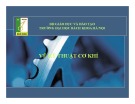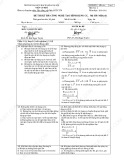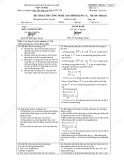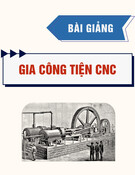
* Corresponding author Tel: +84 0947 485 555
E-mail address: ptthoai@uneti.edu.vn (T. T. H. Pham)
© 2020 by the authors; licensee Growing Science.
doi: 10.5267/j.uscm.2019.8.005
Uncertain Supply Chain Management 8 (2020) 67–76
Contents lists available at GrowingScience
Uncertain Supply Chain Management
homepage: www.GrowingScience.com/uscm
The effect of corporate entrepreneurship, organizational culture on supply chain management
and business performance in chemical industry
Thi Thanh Tam Nguyena, Thi Thuy Hong Nguyenb and Thi Thu Hoai Phamc*
aAcademy of politics region I, Vietnam
bNational Economics University, Vietnam
cUniversity of Economics, Technical for Industries, Vietnam
C H R O N I C L E A B S T R A C T
Article history:
Received July 15, 2019
Received in revised format July
29, 2019
Accepted August 10 2019
Available online
August
10
2019
The article is purposed to assess the impact of corporate entrepreneurship on organizational
culture, supply chain management performance and business performance. Particularly, it
examines the moderating role of organizational culture and corporate size on the relationship
between corporate entrepreneurship and business performance. The research is carried out on
96 chemical companies in Vietnam, using PLS–SEM technique. The results indicate that
organizational culture and company size had moderating role effected positively by corporate
entrepreneurship to business performance through organizational culture and supply chain
management performance.
.by the authors; licensee Growing Science, Canada 2020©
Keywords:
Corporate entrepreneurship
Business performance
Supply chain management
performance
O
rganizational culture
1. Introduction
Chemical industry plays an important role in Vietnam economic development, providing incoming
materials for many necessary manufacturing industries including production and consumption of
fertilizers, paints, printing inks, pesticides, detergents, etc. In 2018, the chemical industry contributed
approximately 3000 million USD, accounting for 1% of total export turnover of Vietnam. There are 8
product categories in the chemical industry: fertilizers and nitrogen compounds, detergents, primary
plastic resins and synthetic rubber, basic chemicals, paints and printing inks, pesticides, man-made
fibers and other chemicals. One of the greatest weakness of the Vietnam chemical industry in 2018 was
poor capability of incoming materials, therefore, most incoming materials for the industry are imported.
In many consecutive years, chemical was always ranked in top 10 the most imported product and China
was the major import market. Almost technical and machinery system in the chemical industry is at
fair average level compared with some regional countries, resulting that production capacity of the
industry is not high and added value is low. In addition, the industry involves with many specific risks,
particularly, risk of safety in use and risk of environmental pollution in the chemical industry. Most
medium and small-sized companies in the industry are facing tough competition with multi-national
corporations with better financial potential, technological level as marketing strategy. Therefore,
entrepreneurship of manager and organizational culture will significantly affect to supply chain

68
management performance and corporate business performance. Research of entrepreneurship were
carried out by many researchers, especially in developed countries. However, in a country with
developing economy like Vietnam, there is a little research of the topic. Particularly it is in the context
of global supply chain of Vietnam chemical industry. The purpose of this article is to measure the effect
of CE to business performance through improvement of supply chain management performance in the
chemical industry. Apart from introduction part, the research includes: Research overview; research
methodology, research result, discussion and recommendation.
2. Literature review and development hypothesis
2.1. Corporate entrepreneurship and business performance
Corporate entrepreneurship (CE) has nourished over the past four decades (Kuratko, 2010). Corporate
entrepreneurship attracted interests of both researchers and corporate managers. CE is an important
factor that helps a corporate develop and builds up its reputation (Ireland et al., 2003). Vietnam
chemical companies in particular and global companies in general always pay attention to and focus on
CE because it creates innovation, persistence, risk tolerance and code of business conduct and social
responsibility (Kuratko & Audretsch, 2009). CE is an important strategy for all types of businesses
(Morris et al., 2011). Previous studies indicated that CE significantly influenced on business
performance (BP) through image improvement, market expansion, “angel investor” attraction and
increase of corporate business performance (Heavey & Simsek, 2013; Frese et al., 2014; Baron &
Kenny, 1986). Therefore, we assume that:
H1: Corporate entrepreneurship is positively associated with business performance.
2.2. Organizational culture and business performance
Organizational culture (OC) (Barney, 1986) is formed and developed in parallel with corporate
development process, not only through a communication culture but also through core values, rules,
management styles, business methods and behaviors, attitudes of all members in a company (Mckinnon
et al., 2003). Organizational culture of a corporate also has decisive effect on occupational spirit,
attitude, motivation of members and use of workforce and other factors help company become a
working community in the spirit of cooperation, trustworthiness, close-knit, friendliness and go-ahead,
thereby establish a common mentality and confidence for the success of a business (Yilmaz & Ergun,
2008). From resource-based view (RBV), OC is a special, unique and inimitable resources of a
corporate (Hall, 1993). Leaders having vision will turn organizational culture into competitive
advantages in a corporate (Kuratko & Welsch, 2004). In addition, entrepreneurship will create positive
OC as an important factor in organizational renovation and development of business activities strategies
in a corporate (Prajogo & Sohal, 2001). Therefore, originating from resource-based view, a corporate
investing and building up organizational culture in a good manner will bring competitive advantages
and business performance in the future. Therefore, we assume that:
H2: Organizational culture is positively associated with business performance.
2.3. Moderating and mediating role of Organizational culture
Covin and Slevin (1991) introduced an integration model analyzing the relationship among corporate
entrepreneurship and environment, strategy, internal control system and organizational performance.
Guth and Ginsberg (1990) reported that there is a two-way mixed relationship between CE and BP. In
contrast, Zahra (1991) pointed that there is no convincing evidence of a direct relationship between CE
and BP. CE helps create a new culture for a corporate, create “start-up” culture, culture of positive
thought, enterprising spirit, always innovate, along with culture of business conduct and social
responsibility. Since then, it gives employees confidence for the success of a corporate and working
with higher productivity resulting in improvement of business performance of a company (Sila &
Ebrahimpour, 2005). Similarly, a corporate with good CE will create good image for investors,

T.T.T. Nguyen et al. /Uncertain Supply Chain Management 8 (2020)
69
customers and stakeholders leading in easy access of capital, customer loyalty to the company and
better business performance. Therefore,
H3: Organizational culture has mediating role in the relationship between CE and BP.
A corporate with positive, unique and inimitable OC will make CE easily successful because it has
good foundation to support for all innovation, access of new science and technology, new market, new
product of a corporate (Prajogo & McDermott, 2005). In case of new project, an innovated company
has to pay costs for research and requires employee engagement and effort and the most important
matter is capital called from “angel investors”, but a “famous” corporate in poor business performance
is hard to carry out successfully a new project and bring good business performance (Zahra & Garvis,
2000). Therefore, we assume that:
H4: Organizational culture has moderating role in the relationship between CE and BP.
2.4 Mediating role of Supply chain management performance
In general, business environment mentioned resources, factors or organizations affecting to business
activities and performance (Le et al., 2019; Phan et al., 2019). Business environment is divided into
two types including internal business environment and external business environment. In the research,
our internal business environment is OC and internal business environment is Supply chain
management performance. While internal business environment can be controlled, external business
environment cannot. Although internal business environment is essential in business planning and
decision-making, but more important thing is that external business environment cannot be controlled
by organizers and managers. A business organization is described as an open system interacting with
external business environment in the basics of symbiosis (Lemghari et al., 2019). On the other hand, a
business organization is benefited from environment and vice versa (Le et al., 2019). Currently, the
chemical industry has been suffered to restructure because of globalization, continuous fluctuation of
raw material price, and closer regulations of the competent authorities. Such challenges require
chemical companies to continuously innovate, increase business acumen, and grasp opportunities for
development. To do so, chemical companies are required to establish a complete supply chain, both
meeting production requirements with minimum cost and ensure maximum safety and environmental
rules. Therefore, CE will increase supply chain management performance, help a corporate increase
business acumen to the environment resulting in improvement of business performance of a corporate.
H5: Supply chain management performance has mediating role in the relationship between CE and BP.
2.5. Mediating role of Size
Large size companies with long-term business performance nearly completed code of conduct,
established specific and unique corporate culture and became competitive advantage of such
companies. At the moment, any corporate play an important role in supply chain of the industry. Then,
CE activities make OC work more effectively and make BP increase significantly by operating leverage
of larger companies. In contrast, with small and medium sized companies, especially newly established
companies, establishment of organizational culture need more time and participation of global supply
chain of such companies is limited. Therefore, it is difficult for a corporate with CE to attract capital
called from “angel investors” and increase immediately business performance. Therefore,
H6: Size has moderating role in the relationship between CE and BP.
3. Methodology
3.1. Sample
Research sample includes 100 chemical companies in Vietnam with full information of director,
address, business status in website http://vtown.vn/category16/genre1503.html. Although, sample size
is small but it covers most of the firms. Survey are sent via email, post office in an envelope with

70
postage stamp for return to 100 companies. Within the first 3 weeks, we collected 36 surveys, then we
made a phone call to each company and asked them to complete the survey. After 3 weeks, we collected
58 more surveys and the remaining 6 surveys was supported by Chemical Association of Vietnam via
email and phone call for collection, finally after 1 more week, we collected these 6 surveys. 100
collected surveys were classified and removed if some of them were incomplete. During the process, 4
invalid surveys were removed and only data in 96 surveys were analyzed. Result of t-tests on
independent sample have shown that there was no significant difference between the responses received
sooner or later based on CE, OC and BP.
3.2. Model Research
Fig.1. Model Research
Corporate entrepreneurship
Entrepreneurship includes policy activities of a corporate in relation to innovation, creation, risk
tolerance, etc. to bring better economic benefits for the future. To measure CE, we use 48 items
developed from research of Umrani and Mahmood (2015) measured in 5 aspects: Work discretion,
Management support, Organizational boundaries, Reward reinforcement, Time availability. Therefore,
CE is the 2
nd
order factor to be measured through 5 aspects expressing development level of innovation
and creation idea and business performance of a corporate. All measuring factors were measured by 5
point Likert scale with from 1 = strongly disagree to 5 = strongly agree. Sample item was: “In my
organization, developing one’s own ideas was encouraged for the improvement of the firm”.
Corporate
entrepreneurship
Management
support
Organizational
boundaries
Reward
reinforceme
nt
Time
availability
Work
discretion
Supply chain
management
performance
Business
performance
Size
Organizational
culture

T.T.T. Nguyen et al. /Uncertain Supply Chain Management 8 (2020)
71
Organizational culture
Culture is a set of values related to a corporate beliefs and behaviors, measured by 18 items developed
from Denison et al. (2014) and Denison (2000). All measuring factors were measured by 5 point Likert
scale with 1 = strongly disagree to 5 = strongly agree. Sample item was: “Cooperation across different
parts of the organization is actively encouraged”.
Business performance
Business performance has shown that business the results of a corporate was evaluated through some
criteria developed from the research by Ali et al. (2010) based on market share, profitability, etc. All
measuring factors were measured by 5 point Likert scale 1 = strongly disagree to 5 = strongly agree.
Sample item was: “Over the past 3 years, our market share has exceeded our largest competitors”.
Supply chain management performance
Supply chain management performance was measured by 5 development criteria from the research of
Holmberg (2000) and Le et al. (2019). Two significant indicators are cost control and guaranteed
performance structure. Cost prevention indicator includes domestic and international costs,
warehousing cost, detention cost and increase of asset revenue. Reliability index reflects in aspects
such as order fulfillment service rate, inventory turnover, safe stocks, inventory obsolescence and the
number of product warranty requests. All measuring factors are measured by 5 point Likert scale with
1 = strongly disagree to 5 = strongly agree
3.3. Research model and Analytical procedures
Analytical procedures
Partial least square (PLS) model is used in present research to test the theoretical model. Reasons for
selecting partial least square (PLS) model are as follows: First, partial least square (PLS) model has
been popular among management sector and related sectors (Hair et al., 2012; Kura, 2016; Kura et al.,
2015; Real et al., 2014; Jose & Manuel, 2012). Second, since the purpose of the research is prediction
of dependent variable, partial least square (PLS) model is considered as appropriate analysis process
(Hair et al., 2011). Thereby, SmartPLS 3.0 software is used in the research. The research used partial
least square (PLS) model to analyze data in the fact that this method is widely applied in academic
research (Hair et al., 2012; Lee et al., 2011). Before carrying out reliability test, validity and structural
path, various assumptions with respect to regularity and polymorphism, common method deviations
were evaluated (Hair et al., 2010). A process of two steps was used in the research, including: (1)
assessment of measurement model; and (2) assessment of structural model, to assess and report PLS-
SEM report (Hair et al., 2010, 2014; Henseler et al., 2009). Measurement model assessment according
to Hair et al. (2010, 2014) and Henseler et al. (2009) was carried out to assess measurement model;
researchers needed to identify the reliability of each item and internal consistency, content validity,
convergent validity and discriminant validity. Reliability of each latent variable should be assessed by
considering external load of each measuring factor of each latent variable (Hair et al., 2012, 2014).
Researchers gave a rule of thumb to retain the variables for which Cronbach Alpha values are > 0.70
(Hair et al., 2014). External load of each latent variable of the research > 0.5. Assessment of convergent
validity and average variance extracted (AVE) is proposed by Fornell and Larcker (1981). However,
according to Chin (1998, 2010), Chin et al. (2003) and Esposito Vinzi et al. (2010), AVE greater than
0.5 expresse convergent validity of specific latent variable. Differentiation value is assessed according
to criteria of Fornell and Larcker (1981). According to normal principle, Fornell and Larcker proposed
to use AVE with value > 0.5. However, in order to determine validity of differentiation value, square
roots of AVE must be higher than the relationship between latent variables.
Assessment of structural model: Standard bootstrapping process has been used in the research with 500
bootstrap samples to determine importance of path coefficients after Hair et al. (2011, 2012, 2014) and
Henseler et al. (2009). Variance evaluation is explained in endogen latent variable. Assessment of










![Đề thi Công nghệ tạo hình dụng cụ năm 2020-2021 - Đại học Bách Khoa Hà Nội (Đề 4) [Kèm đáp án]](https://cdn.tailieu.vn/images/document/thumbnail/2023/20230130/phuong62310/135x160/3451675040869.jpg)










![Bài tập môn Cơ sở thiết kế máy [năm] [mới nhất]](https://cdn.tailieu.vn/images/document/thumbnail/2025/20251008/ltgaming1192005@gmail.com/135x160/26601759980842.jpg)


![Tài liệu huấn luyện An toàn lao động ngành Hàn điện, Hàn hơi [chuẩn nhất]](https://cdn.tailieu.vn/images/document/thumbnail/2025/20250925/kimphuong1001/135x160/93631758785751.jpg)

